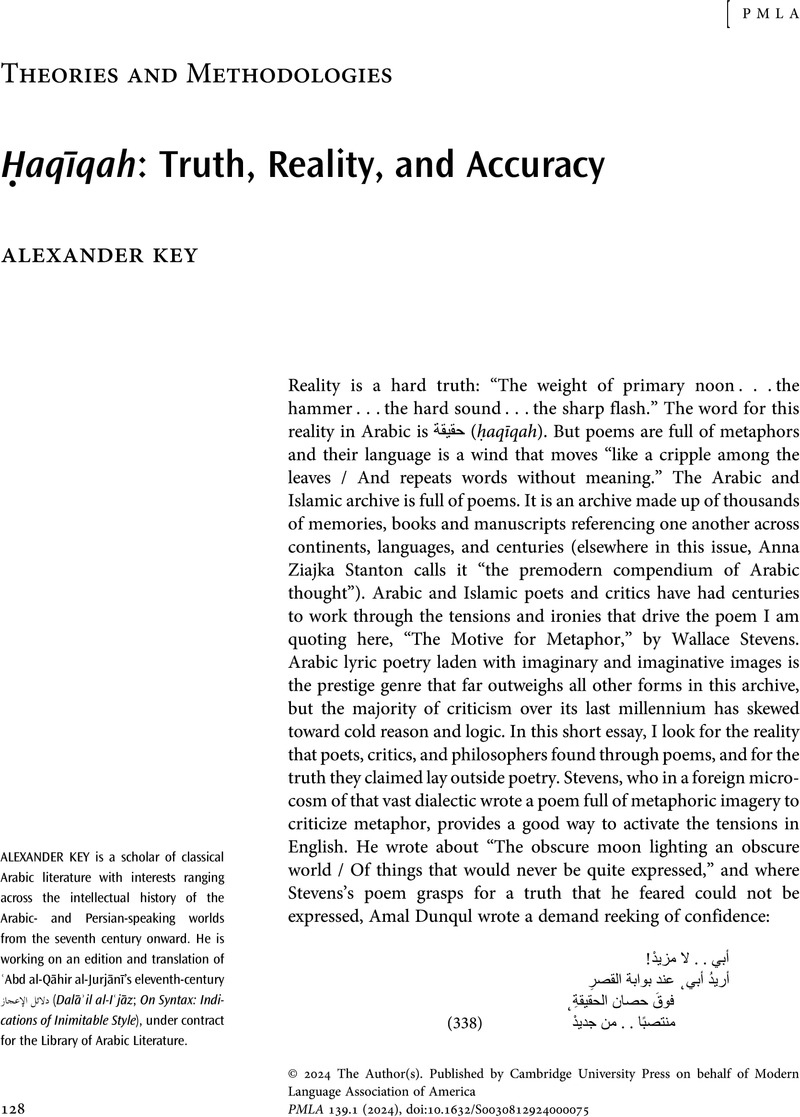No CrossRef data available.
Article contents
Ḥaqīqah: Truth, Reality, and Accuracy
Published online by Cambridge University Press: 17 April 2024
Abstract
An abstract is not available for this content so a preview has been provided. Please use the Get access link above for information on how to access this content.

- Type
- Theories and Methodologies
- Information
- Copyright
- Copyright © 2024 The Author(s). Published by Cambridge University Press on behalf of Modern Language Association of America
References
Works Cited
Ajami, Mansour. The Alchemy of Glory: The Dialectic of Truthfulness and Untruthfulness in Medieval Arabic Literary Criticism. Three Continents Press, 1988.Google Scholar
Ajami, Mansour. Pouring Water on Time: A Bilingual Topical Anthology of Classical Arabic Poetry. Gerlach Press, 2016.CrossRefGoogle Scholar
Ali, Mohamed Mohamed Yunis. Medieval Islamic Pragmatics: Sunni Legal Theorists’ Models of Textual Communication. Curzon, 2000.Google Scholar
Çelebi, Ḥasan Muḥammad Shāh Ibn al-Fenārī. حاشية المطول [Ḥāshīyat al-Muṭawwal]. 1892. Manshūrāt al-Sharīf al-Riḍā, 1986.Google Scholar
Donoghue, Denis. “The Motive for Metaphor.” The Hudson Review, vol. 65, no. 4, winter 2013, pp. 543–61. JSTOR, www.jstor.org/stable/43489263.Google Scholar
Dunqul, Amal. الأعمال الشعرية الكاملة [Al-Aʿmāl al-Shiʿriyyah al-Kāmilah]. Maktabat Madbūlī, 1987.Google Scholar
El-Khoury, Alfred. The Old and the New in Premodern Arabic Poetry: Metaphor as Vantage Point. 2023. Otto-Friedrich-Universität Bamberg, PhD dissertation.Google Scholar
Gleave, Robert. Islam and Literalism: Literal Meaning and Interpretation Islamic Legal Theory. Edinburgh UP, 2013.Google Scholar
Ḥallāj, al-Ḥusayn ibn Manṣūr al-. “Love Has Always Been.” Translated by Key, Alexander. Lyrics of Ascent: Poetry and the Platonic Tradition: An Anthology, 2022, lyrics-of-ascent.net/al-hallaj/.Google Scholar
Harb, Lara. Arabic Poetics: Aesthetic Experience in Classical Arabic Literature. Cambridge UP, 2020.CrossRefGoogle Scholar
Heinrichs, Wolfhart. Arabische Dichtung und Griechische Poetik: Ḥāzim al-Qarṭāǧannīs Grundlegung der Poetik mit Hilfe Aristotelischer Begriffe. Franz Steiner Verlag, 1969.Google Scholar
Hussein, Ali Ahmad. The Rhetorical Fabric of the Traditional Arabic Qaṣīda in Its Formative Stages: A Comparative Study of the Rhetoric in Two Traditional Poems by ʿAlqama l-Faḥl and Bashshār b. Burd. Harrassowitz Verlag, 2015.Google Scholar
Ibn Fāris, Abū al-Ḥasan Aḥmad. معجم مقاييس اللغة [Muʿjam Maqāyīs al-Lughah]. Edited by ʿAbd al-Salām, M. Hārūn, Dār al-Fikr, 1979. 6 vols. Internet Archive, archive.org/details/FP10288.Google Scholar
Ibn Taymiyyah, Aḥmad. مجموع فتاوى شيخ الإسلام ابن تيمية [Majmūʿ Fatāwā Shaykh al-Islām Aḥmad ibn Taymiyyah]. Edited by ʿAbd al-Raḥmān ibn Muḥammad and Muḥammad ibn ʿAbd al-Raḥmān, Maṭābiʿ al-Riyāḍ, 1961–67. 37 vols.Google Scholar
Imruʾ al-Qays. Dīwān. Edited by al-Faḍl Ibrāhīm, Muḥammad Abū, al-Maʿārif, Dār, 1994. Internet Archive, archive.org/details/FP4428.Google Scholar
Jurjānī, ʿAbd al-Qāhir al-. أسرار البلاغة [Asrār al-Balāghah]. Edited by Ritter, Helmut, Istanbul Government Press, 1954.Google Scholar
Key, Alexander. Language between God and the Poets: Maʿnā in the Eleventh Century. U of California P, 2018.Google Scholar
Key, Alexander. “Philosophy of Language.” Encyclopedia of Islam, Three, Brill, forthcoming.Google Scholar
Khansāʾ, Tumāḍir bint ʿAmr al-. أنيس الجلساء في شرح ديوان الخنساء [Anīs al-Julasāʾ fī Sharḥ Diwān al-Khansāʾ]. Edited by Cheikho, Louis, Catholic Press, 1896.Google Scholar
Mohanty, Satya P. “Reference.” The Oxford Encyclopedia of Literary Theory, Oxford UP, 2022, www-oxfordreference-com.stanford.idm.oclc.org/view/10.1093/acref/9780190699604.001.0001/acref-9780190699604-e-1157.Google Scholar
Moi, Toril. Revolution of the Ordinary: Literary Studies after Wittgenstein, Austin, and Cavell. U of Chicago P, 2017.CrossRefGoogle Scholar
Noy, Avigail. “Did the Arabic Lexicographers Invent Majāz?” Journal of the American Oriental Society, vol. 141, no. 4, 2021, pp. 803–22.CrossRefGoogle Scholar
Qudāmah ibn Jaʿfar. كتاب نقد الشعر [Kitāb Naqd al-Shiʿr]. Edited by Bonebakker, S. A., Brill, 1956.Google Scholar
Rāghib al-Iṣfahānī, Abū al-Qāsim al-Ḥusayn al-. أفانين البلاغة [Afānīn al-Balāghah]. Edited by al-Sanawī, ʿUmar Mājid, Arwiqah li-l-Dirāsāt wa-l-Nashr, 2020.Google Scholar
Rāghib al-Iṣfahānī, Abū al-Qāsim al-Ḥusayn al-.. مفردات أفاظ القرآن [Mufradāt Alfāẓ al-Qurʾān]. Edited by Dāwūdī, Ṣafwān, Dār al-Qalam / Dār al-Shāmiyyah, 2009. Internet Archive, archive.org/embed/FP106319.Google Scholar
Sharīf al-Jurjānī, ʿAlī ibn Muḥammad al-. معجم التعريفات [Muʿjam al-Taʿrīfāt]. Edited by al-Minshāwī, Muḥammad Ṣiddīq, Dār al-Faḍīlah, [2004]. Internet Archive, archive.org/details/waq111440.Google Scholar
Siyālkūtī, ʿAbd al-Ḥakīm al-. حاشية السيالكوتي على كتاب المطول [Ḥāshiyat al-Siyālkūtī ʿalā Kitāb al-Muṭawwal li-l-Taftazānī]. Edited by ʿUthmān, M. al-S., Dār al-Kutub al-ʿIlmīyah, 2012.Google Scholar
Stevens, Wallace. “The Motive for Metaphor.” The Collected Poems of Wallace Stevens, edited by Serio, John N. and Beyers, Chris, Vintage Books, 2015, p. 304.Google Scholar
Vendler, Helen. The Ocean, the Bird, and the Scholar: Essays on Poets and Poetry. Harvard UP, 2015. EBSCOhost, search.ebscohost.com/login.aspx?direct=true&db=nlebk&AN=986219&site=ehost-live.CrossRefGoogle Scholar




